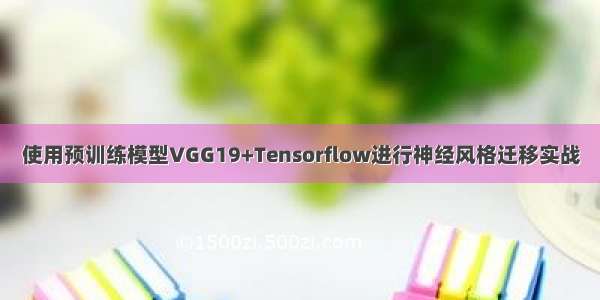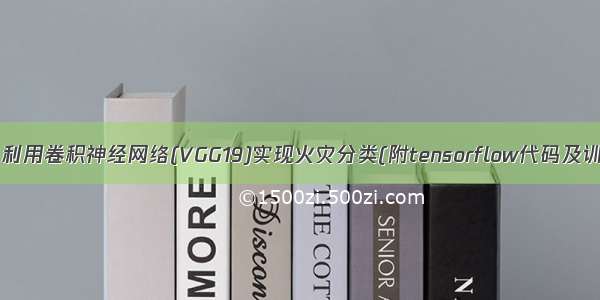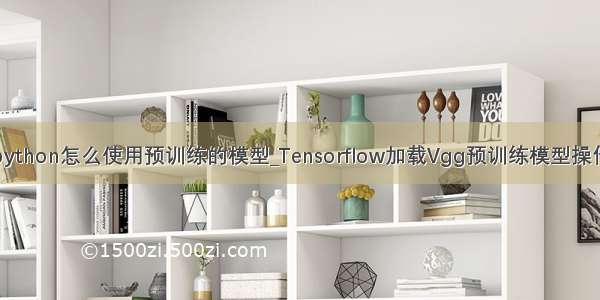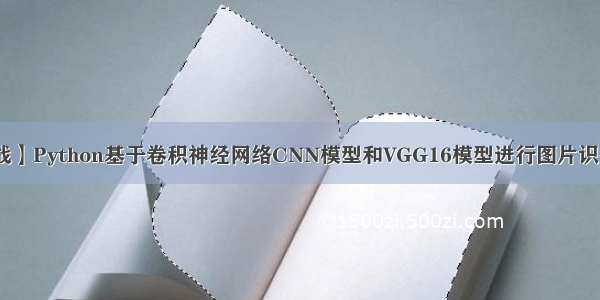
神经风格迁移
前言正文库、包、模板图像预处理构建神经风格迁移模型VGG19预训练模型基于VGG19自定义模型代价函数内容代价函数风格代价函数总代价函数训练模型结果展示总结源码参考一笔一划,一个世界前言
本次搭建的卷积神经网络使用了VGG19预训练模型搭建神经风格迁移模型,所以使用CPU整个训练过程也很快。环境和库:windows10+pycharm+tensorflow+keras+python+CPU使用tensorflow_hub可以快速体验神经风格迁移,不过需要VPNimport tensorflow_hub as hub# 如果搭了VPN还是出现超时的问题,可以直接点开该url,# 然后直接download压缩文件,# 然后解压后把解压后的文件夹路径替换该url即可hub_module = hub.load('https://tfhub.dev/google/magenta/arbitrary-image-stylization-v1-256/1')stylized_image = hub_module(tf.constant(content_image), tf.constant(style_image))[0]# 自定义函数tensor_to_image,实现见下文tensor_to_image(stylized_image)
正文
库、包、模板
import numpy as npimport pandas as pdimport tensorflow as tfimport keras.preprocessing.image as process_imfrom keras.applications import vgg19from keras.models import Modelfrom tensorflow.python.keras import modelsfrom tensorflow.python.keras import lossesfrom tensorflow.python.keras import layersfrom tensorflow.python.keras import backend as kfrom PIL import Image# Python Image Libraryimport matplotlib.pyplot as plt# 可视化库import functools# 用以为可调用对象(callable objects)定义高阶函数或操作import IPython.display# python的交互式shell
图像预处理
PIL中的image对象调用resize方法,此处将图像进行缩放为某高宽的高质量图像img_to_array转换前后类型都是一样的,唯一区别是转换前元素类型是整型,转换后元素类型是浮点型(和keras等机器学习框架相适应的图像类型。Keras introduced a special function called img_to_array which accepts an input image and then orders the channels correctly based on the image_data_format setting)expand_dims在数组中增加一个维度,reshape能够达到相同的效果作用:加载图像;将图像等比例缩放,最长边为512;并返回图像对应三维数组源码:# 加载图像;将图像进行缩放,最长边为512;并将图像转换为array输出def load_img(img_path):""":param img_path: :return: """max_dim = 512img = tf.io.read_file(img_path) # codedimg = tf.image.decode_image(img, channels=3) # 0-255img = tf.image.convert_image_dtype(img, tf.float32) # 0-1shape = tf.cast(tf.shape(img)[:-1], tf.float32)long_dim = max(shape)scale = max_dim / long_dimnew_shape = tf.cast(shape * scale, tf.int32)img = tf.image.resize(img, new_shape)img = img[tf.newaxis, :] # 升维,便于卷积神经网络处理return img
构建神经风格迁移模型
VGG19预训练模型
函数原型如下,返回一个Kera Model对象keras.applications.vgg19.VGG19(include_top=True,weights='imagenet', input_tensor=None,input_shape=None, pooling=None,classes=1000)
有点儿不理解include_top的用法,文档中说:是否包括顶层的全连接层,但是还是有点儿不清楚,所以直接调用model.summary()来一探究竟,结果是:是否删去所有的全连接层还有对于pooling的用法,实验说明:表示在include_top=False时,最后一层是否要加上一层什么样的池化层。注意:最后一块的最后一层本来就有一层最大池化层此处我们使用VGG19预训练模型对于VGG19的需求如下:不需要最后的全连接层(include_top=False)、需要预训练权重(weights=‘imagenet’)、其他为默认值。
基于VGG19自定义模型
整个模型的输入即为VGG19的输入,而输出则需要根据神经风格迁移网络的代价函数来定,我们需要提取内容图像中的内容、风格图像中的风格(blog),由此可知:内容代价函数我们需要提取靠近中间的某层的激活值输出,风格代价函数我们需要提取每一层的激活值输出。值得一提的是:我们自定义好的模型之后,一些完全无关的层会被自动剔除,可用model.summary()验证对于VGG19来说,模型结构如下图所示:需要提取的层的激活值如下所示
content_layers = ['block5_conv2']style_layers = ['block1_conv1','block2_conv1','block3_conv1','block4_conv1','block5_conv1']
在搞明白以上内容之后,我们可以调用models.Model(input=, output=)构建我们需要的神经风格迁移模型了。
content_layers = ['block5_conv2']style_layers = ['block1_conv1','block2_conv1','block3_conv1','block4_conv1','block5_conv1']# get the neural transfer modeldef get_model(content_layers_names, style_layers_names):""":param content_layers_names: content layers names list:param style_layers_names: style layers name list:return: neural transfer model"""vgg = tf.keras.applications.vgg19.VGG19(include_top=False) # 删掉最后一层;默认加载ImageNet上的预训练权重vgg.trainable = False # 参数不可训练# get the content layer and style layercontent_output = [vgg.get_layer(name=layer).output for layer in content_layers_names]style_output = [vgg.get_layer(name=layer).output for layer in style_layers_names]model_output = style_output + content_output # list combine# get the neural transfer modelneural_transfer_model = models.Model([vgg.input], model_output)return neural_transfer_model
代价函数
内容代价函数
内容直接定义为内容层的激活值,所以内容代价函数定义为激活值的均方差误差MSE# get content lossdef content_loss_layer(output_layer, target_layer):""":param output_layer::param target_layer::return: some layer content loss"""# MSE, all elementscontent_loss = tf.reduce_mean(tf.square(output_layer - target_layer))return content_loss
风格代价函数
风格定义为不同通道之间激活值的相关系数,每一层有一个风格矩阵(即为Gram矩阵),风格代价函数定义类似于风格矩阵的均方误差# get the gram matrix for style costdef gram_matrix(layer):""":param layer: some layer of model:return: Gram matrix"""channels = int(layer.shape[-1])# 通道数为layer最后一层的维度vector = tf.reshape(layer, [-1, channels]) # reshape to n*channeln = tf.shape(vector)[0]# n=nw*nh# vector.T*vectorgram = tf.matmul(vector, vector, transpose_a=True)return gram / tf.cast(n, tf.float32)# get some layer style lossdef style_loss_layer(output_layer, target_layer):""":param output_layer::param target_layer::return:"""# get the gram matrix of the layergram_output = gram_matrix(output_layer)gram_target = gram_matrix(target_layer)# use the gram to compute the loss of some layer# /(nw*nh*nc)style_loss = tf.reduce_mean(tf.square(gram_target - gram_output))return style_loss
总代价函数
总代价函数由内容代价函数和风格代价函数通过加权和得来为什么在get_features方法中截取content_feature&style_feature的时候用的layer[0],要解决这个问题必须要理解每一层的激活值到底是什么样的结构!同样的问题:在neural_transfer_cost方法中对输出图像的输出激活值只去第零维的值源码:# get the style layer output and content layer outputdef get_features(neural_transfer_model, content_image, style_image):""":param neural_transfer_model::param content_image::param style_image::return: """content_image = content_image*255.style_image = style_image*255.# preprocess the content image and style imagecontent_image = tf.keras.applications.vgg19.preprocess_input(content_image)style_image = tf.keras.applications.vgg19.preprocess_input(style_image)# input the preprocessed content image and style image# get the output of the neural transfer modelcontent_output = neural_transfer_model(content_image)style_output = neural_transfer_model(style_image)# extract the content layer output and style layer outputcontent_feature = [layer for layer in content_output[number_style:]]style_feature = [layer for layer in style_output[:number_style]]return content_feature, style_feature# get the cost of neural transfer modeldef neural_transfer_cost(neural_transfer_model, loss_weights, output, target_style_features, target_content_features):""":param neural_transfer_model::param loss_weights::param output::param target_style_features::param target_content_features::return: model cost"""# initial varstyle_weight, content_weight = loss_weightscontent_loss = 0style_loss = 0# get output image features# 0-1 --> 0.-255.output = output*255.output = tf.keras.applications.vgg19.preprocess_input(output)output_features = neural_transfer_model(output)output_style_features = output_features[:number_style]output_content_features = output_features[number_style:]# get the style lossfor i, j in zip(target_style_features, output_style_features):style_loss += style_loss_layer(i, j)style_loss *= 1. / number_style# get the content lossfor i, j in zip(target_content_features, output_content_features):content_loss += content_loss_layer(i, j)content_loss *= 1. / number_content# get the total cost of neural transfer modeltotal_cost = content_weight * content_loss + style_weight * style_lossreturn total_cost
训练模型
使用参数字典作为方法参数with tf.GradientTape() as tape:在context manager中监视计算过程,随后可以调用tape来计算偏导tf.clip_by_value将tensor的值限制在一定范围内var.numpy()是什么意思?def run_style_transfer(content_image, style_image, epochs=500, content_weight=1e3, style_weight=1e-2):""":param content_image::param style_image::param epochs::param content_weight::param style_weight::return:"""# get the neural style modelneural_transfer_model = get_model(content_layers_names=content_layers, style_layers_names=style_layers)# get the content layer and style layer features of content image and style imagetarget_content_feature, target_style_feature = get_features(neural_transfer_model, content_image, style_image)# output imageoutput = tf.keras.applications.vgg19.preprocess_input(content_image)output = tf.Variable(output, dtype=tf.float32)# loss weightsloss_weights = (style_weight, content_weight)dictionary = {'neural_transfer_model': neural_transfer_model,'loss_weights': loss_weights,'output': output,'target_style_features': target_style_feature,'target_content_features': target_content_feature}# get the optimizeroptimizer = tf.keras.optimizers.Adam(learning_rate=0.02, beta_1=0.99, epsilon=1e-1)start_time = time.time()start_50_epochs = time.time()for i in range(epochs):with tf.GradientTape() as tape:model_cost = neural_transfer_cost(**dictionary)grad = tape.gradient(model_cost, output)optimizer.apply_gradients([(grad, output)])clipped = tf.clip_by_value(output, 0, 1)output.assign(clipped)# for visualizationif i % 50 == 0:end_50_epochs = time.time()print('Epoch:{}, duration:{}s'.format(i, end_50_epochs-start_50_epochs))print('Total loss: {:.4e}, '.format(model_cost))print('----------------------------------------------')start_50_epochs = time.time()plt.imshow(tensor_to_image(output))# 0-1, (1 512 512 3) tf.Variable float32plt.show()IPython.display.clear_output(wait=True)end_time = time.time()print(str(end_time - start_time) + 's')return output
结果展示
第一次用的广州塔的图片和梵高的星空,然后效果不是特别好,可能在参数方面需要调整。图我就不放了,效果不太行,有点丑。然后我就换成了小黄狗,左图迭代10次,右图迭代大概100次,可以看到效果是不错的。源码:# 显示图像和图像标题def show_im(img, title=None):""":param img::param title:"""if len(img.shape) > 3:image = tf.squeeze(img, axis=0)plt.imshow(image)if title:plt.title(title)plt.show()# get and show content image and style image content_path = './input/to.jpg'style_path = './input/vagao.jpg'content_image = load_img(content_path)style_image = load_img(style_path) # (1 512 512 3), ndarry, float32, 0-1show_im(content_image)show_im(style_image)# content layers and style layerscontent_layers = ['block5_conv2']style_layers = ['block1_conv1','block2_conv1','block3_conv1','block4_conv1','block5_conv1']number_content = len(content_layers)number_style = len(style_layers)# run the style transferimage_neural_transfer = run_style_transfer(content_image, style_image, epochs=1000)# show the resultimage_neural_transfer = tensor_to_image(image_neural_transfer)plt.imshow(image_neural_transfer)plt.show()
总结
主要练习两个内容:如何使用预训练模型、如何搭建神经风格迁移模型在实现过程中遇到了不少麻烦,一直感觉:输出的图像有问题,但是应该不是模型的问题,而是数据类型转换的时候搞错了@.@第二天更新:输出图像怪怪的(指广州塔)。现在解决了一个问题:弄清楚了图像输入的格式、图像显示的格式。vgg19.preprocess_input()的输入要求0.-255.,输出层的输出0.-1.,计算代价函数的输入0.-1.,所以要特别注意源码
想了想还是不直接贴全部源码了# 无














